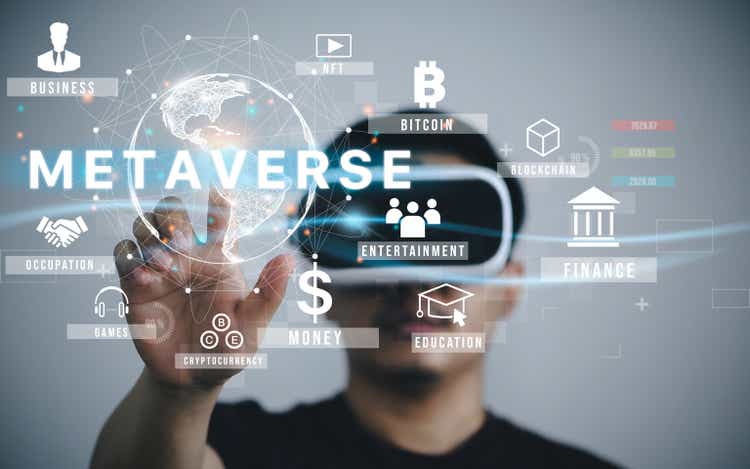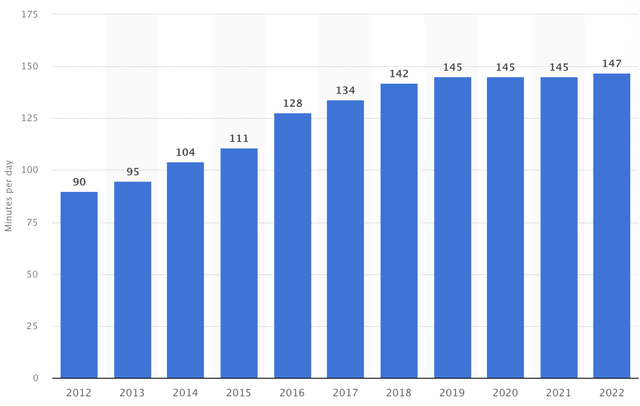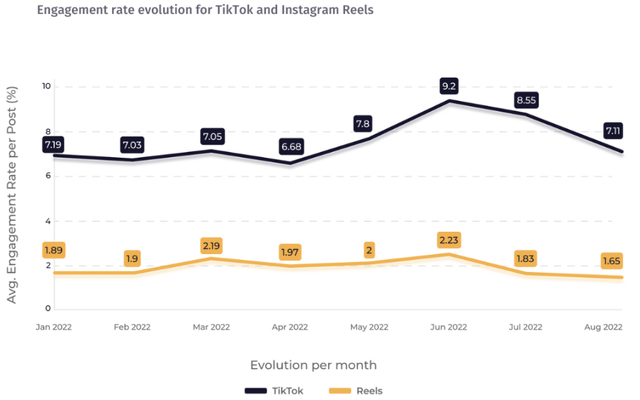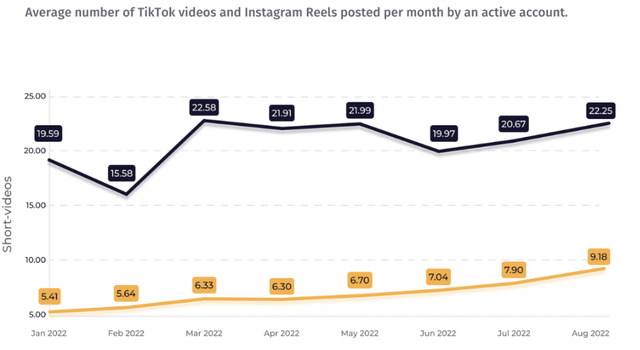Summary:
- Amid the corporate name change and billion-dollar metaverse investments, it is easy to forget that the fortunes of Meta Platforms are closely tied to the social media industry.
- Social media is not what it used to be just a couple of years ago.
- This analysis discusses how the social media industry is changing dynamically and evaluates whether Meta Platforms is ready to thrive in social media 2.0.

Khanchit Khirisutchalual
Meta Platforms’ (NASDAQ:META) stock, after a torrid start to 2022, has gained more than 30% since November. These gains, however, pale in comparison to the 57% erosion of Meta’s market value in the last 12 months. The slowdown in ad spending, lackluster returns from billions of dollars invested in the metaverse, layoffs, and the company’s struggles in attracting young users have played a part in Meta’s recent struggles. As the metaverse continues gaining traction as the future of tech, many companies have embraced the metaverse. At a time like this, it is easy for investors to forget that Meta Platforms is as much about social media as it is about the metaverse. In fact, Meta’s prospects in the next five years will largely depend on its ability to stay on top of the social media hierarchy. This analysis discusses a few emerging trends in the social media sector that are changing the dynamics of the playing field and how Meta seems to be on top of its game even at a challenging time like this.
The Evolving Social Media Industry
The social media industry has attracted a lot of attention since the pandemic as individuals turned to these platforms to stay connected with friends and family at a time they were ordered to stay at home. At the same time, restaurants, events, schools, and businesses remained closed. There was a significant increase in social media usage in the early days of the pandemic. For example, during the pandemic, data from the social media platform Facebook showed that people were using the platform for more extended periods of time, and engagement increased as much as 50% in some countries. Time spent on social media and the number of social media users increased by 11% globally, from roughly 3.4 billion in 2019 to 3.78 billion in 2021. Furthermore, the creator economy has introduced new trends that resulted in an increase in usage with time spent increasing from 56 minutes per day in 2019 to 65 minutes in 2021 in the United States.
Exhibit 1: The average daily time spent on social media by Internet users worldwide

Statista
Source: Statista
The way social media users consume content has changed over the years, and there are various types of content that grab the attention of users today including but not limited to text posts, pictures, infographics, gifs, live videos, short-form videos, and listicles. Out of these, short-form videos have had the most profound impact on the social media industry in the last couple of years with the rise of TikTok. From a technological perspective, Artificial Intelligence is having a massive impact on the way people use social media as well. Mixed reality, on the other hand, is emerging as a must-have technology on social media platforms. In the remainder of this analysis, these new developments will be discussed along with what Meta Platforms is doing to stay ahead of the competition.
Short-Form Video Content
Short-form video content refers to videos that are typically 60 seconds or shorter in length and are designed to be consumed quickly. Short-form video content has become increasingly popular on social media platforms in recent years, and there are a few reasons why:
- Easy to consume: short-form videos are easy to watch and understand, making them perfect for busy users who don’t have a lot of time to spend on social media.
- Shareable: video content is highly shareable, which means that it can easily go viral and reach a large audience. This is especially true on platforms like TikTok, which is known for its short, catchy videos.
- Cost-effective: it is typically less expensive to produce short-form videos than longer-form content, which makes it more accessible to a wider range of creators.
- Adaptable: Content can be created for a variety of purposes, such as entertainment, education, or advertising, and can be easily repurposed and shared on multiple platforms.
The growing popularity of short-form video content on social media can be attributed to the aforementioned reasons. TikTok is the undisputed leader in short-form content, which is something investors will agree on. Facebook and Instagram launched Reels in a bid to attract and retain users who were flocking to TikTok. Reels have already become a very popular content consumption method on both Facebook and Instagram, but TikTok’s authority seems far superior when it comes to short-form video content.
Exhibit 2: TikTok vs Reels – engagement rate by followers

Socialinsider
Source: Socialinsider
Exhibit 3: TikTok vs Reels – posting frequency

Socialinsider
Source: Socialinsider
Meta Platforms may be behind TikTok when it comes to embracing short-form video content but the company is moving in the right direction by embracing the new paradigm shift.
The Impact of AI on Social Media
Artificial Intelligence (AI) has been introduced to social media platforms in a variety of ways to improve the user experience, including content recommendation, personalization, moderation, and advertising.
- Content recommendation: AI algorithms are used to recommend content to users based on their interests and past behavior. For example, YouTube uses AI to recommend videos to users based on their watch history, and Facebook uses AI to suggest pages and groups that users might be interested in joining.
- Personalization: AI is used to personalize the content that users see on their social media feeds. For example, Facebook’s News Feed algorithm uses AI to rank and filter the posts that users see based on their interests and interactions with the platform.
- Moderation: AI is used to help moderate and filter content on social media platforms. For example, Facebook uses AI to identify and remove inappropriate or offensive content from the platform.
- Advertising: AI is used to target and deliver advertising to users on social media platforms. For example, Facebook’s ad targeting system uses AI to match ads to users based on their interests and demographics.
Meta Platforms’ tech investments in the last few years are paying off today with the company using AI to create a better user experience for active users on Facebook and Instagram while expanding monetization opportunities. The company may be behind TikTok when it comes to short-form content but is years ahead of many of its rivals in embracing AI technology.
Mixed Reality and Social Media
Mixed reality (MR) refers to the combination of virtual reality (VR) and augmented reality (AR), which allows users to experience and interact with virtual objects in the real world. Social media platforms are introducing mixed reality for a number of reasons. The primary goal is to enhance the user experience and attract new users. MR can provide a more immersive and interactive experience for users on social media platforms. For example, AR filters can allow users to try on different virtual looks or visit virtual events, which can be more engaging than traditional static content. This results in attracting and retaining new users who are interested in immersive and interactive experiences. By offering MR features, platforms can differentiate themselves from their competitors and appeal to a wider audience. Additionally, MR can help in driving engagement as it provides users with new and exciting ways to interact with content and with each other such as VR events that can bring users together in a virtual space. With an increase in user numbers, these platforms can generate revenue by allowing them to charge brands to create and promote AR filters, or they can sell tickets to VR events in the future as well.
MR has been implemented on social media platforms in a few ways, including:
- AR filters: many social media platforms, including Instagram and Snapchat, offer AR filters that users can apply to their photos and videos. These filters add virtual elements such as masks, hats, and makeup to the user’s appearance.
- VR events: some social media platforms, such as Facebook, have begun hosting VR events that users can attend virtually. These events can range from concerts and sports games to conferences and workshops.
- MR advertising: MR has also been used to create immersive and interactive advertising experiences on social media platforms. For example, brands have used AR filters on Instagram to promote products, and Facebook has used VR to create virtual storefronts for users to browse and purchase products.
Snapchat, owned by Snap Inc. (SNAP), was one of the first social media platforms to offer users a VR experience, but Facebook and Instagram are catching up fast. Meta Platforms, with the aid of Oculus, is well-positioned to become the market leader in offering users innovative virtual reality experiences.
Takeaway: Meta Platforms Is The Complete Package
Social media, as we know it, is changing. In the early days of the industry, the focus was on providing users with a seamless experience to connect with friends and family. Today, social media usage is centered around content, not people. Meta Platforms has identified this shift, which is evident from some of the products the company has launched on Facebook and Instagram recently. Although competitive threats remain a concern, Meta has created a platform to successfully mitigate these challenges in the long run. Unlike many of its peers, Meta is profitable, has a strong balance sheet, and is valued like a mature company at a P/E of 14.9 despite having years of growth ahead. Meta Platforms, therefore, is the complete package for growth investors looking for opportunities in the social media sector.
Disclosure: I/we have a beneficial long position in the shares of META either through stock ownership, options, or other derivatives. I wrote this article myself, and it expresses my own opinions. I am not receiving compensation for it (other than from Seeking Alpha). I have no business relationship with any company whose stock is mentioned in this article.

The unexpected moment is always sweeter
At Leads From Gurus, we strive to achieve sweet returns by predicting which companies would report unexpected earnings. Join us to discover the power of earnings surprises.
Your subscription includes access to:
- Weekly actionable ideas that would help you beat the market.
- In-depth research reports on stocks that are well-positioned to beat earnings estimates.
- Three model portfolios designed to help you beat the market.
- Educational articles discussing the strategies followed by gurus.
- An active community of like-minded investors to share your findings.
Act now to secure the launch discount!

